 Facebook
Facebook
 X
X
 Instagram
Instagram
 TikTok
TikTok
 Youtube
Youtube

Acacias, festooned with myriads of fluffy yellow blossoms, are brightening streetsides, freeway embankments, and backyard gardens throughout the San Diego area this month. Although many acacias are native to subtropical regions, nearly all we see today in San Diego were introduced from Australia. The Anza-Borrego Desert’s native acacia (Acacia greggii) is the notoriously thorny “catclaw,” known by early desert pioneers as “tear-blanket” and “wait-a-minute bush.”
The Frost-Nipped Legacies of November’s and December’s colder weather aren’t hard to spot. Brown lawns, half-dead-looking avocado trees, and wilted ornamental plants like poinsettias in certain areas of San Diego County tell the story plainly enough. But a common frost-sensitive native plant — the laurel sumac — is even more widely expressive. Laurel sumac is one of the largest and most conspicuous plants within the coastal-sage-scrub vegetation community growing on many of San Diego’s coastal hillsides. Laurel sumacs tend to become noticeably frost-bitten in low lying areas, where chilled air sinks and settles in during the night and early morning hours.
The Planet Jupiter remains prominent in the southwestern sky after dark in January through February; it will be ever lower in the sky into late February and March. In early April, Jupiter will be in conjunction with the sun, and we will not see it again until it becomes visible in the early-morning sky in May. On the eastern side of the sky, at dawn, Venus remains prominent, appearing as a brilliant “morning star” through March and beyond.


Acacias, festooned with myriads of fluffy yellow blossoms, are brightening streetsides, freeway embankments, and backyard gardens throughout the San Diego area this month. Although many acacias are native to subtropical regions, nearly all we see today in San Diego were introduced from Australia. The Anza-Borrego Desert’s native acacia (Acacia greggii) is the notoriously thorny “catclaw,” known by early desert pioneers as “tear-blanket” and “wait-a-minute bush.”
The Frost-Nipped Legacies of November’s and December’s colder weather aren’t hard to spot. Brown lawns, half-dead-looking avocado trees, and wilted ornamental plants like poinsettias in certain areas of San Diego County tell the story plainly enough. But a common frost-sensitive native plant — the laurel sumac — is even more widely expressive. Laurel sumac is one of the largest and most conspicuous plants within the coastal-sage-scrub vegetation community growing on many of San Diego’s coastal hillsides. Laurel sumacs tend to become noticeably frost-bitten in low lying areas, where chilled air sinks and settles in during the night and early morning hours.
The Planet Jupiter remains prominent in the southwestern sky after dark in January through February; it will be ever lower in the sky into late February and March. In early April, Jupiter will be in conjunction with the sun, and we will not see it again until it becomes visible in the early-morning sky in May. On the eastern side of the sky, at dawn, Venus remains prominent, appearing as a brilliant “morning star” through March and beyond.
Comments